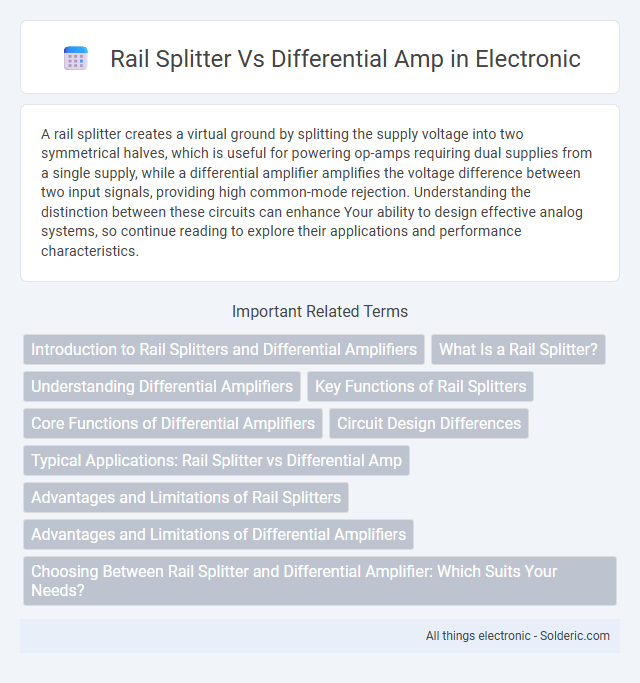A rail splitter creates a virtual ground by splitting the supply voltage into two symmetrical halves, which is useful for powering op-amps requiring dual supplies from a single supply, while a differential amplifier amplifies the voltage difference between two input signals, providing high common-mode rejection. Understanding the distinction between these circuits can enhance Your ability to design effective analog systems, so continue reading to explore their applications and performance characteristics.
Comparison Table
| Feature | Rail Splitter | Differential Amplifier |
|---|---|---|
| Function | Generates a mid-rail voltage reference from a single supply | Amplifies the voltage difference between two input signals |
| Primary Use | Creates virtual ground for single-supply circuits | Signal conditioning and noise rejection in measurement systems |
| Input | Single voltage rail (e.g., +5V) | Two input voltages (differential inputs) |
| Output | Stable midpoint voltage (virtual ground) | Amplified difference voltage |
| Complexity | Simple circuit, often using an op-amp and resistor divider | More complex design, typically an op-amp with matched resistors |
| Noise Immunity | Does not inherently reject noise | High noise rejection due to differential input |
| Applications | Single supply sensor interfaces, audio circuits, biasing | Instrumentation, data acquisition, sensor signal amplification |
Introduction to Rail Splitters and Differential Amplifiers
Rail splitters generate a reference voltage midpoint between supply rails, enabling single-supply op-amp circuits to simulate dual power supplies, which is essential for analog signal processing. Differential amplifiers amplify the voltage difference between two input signals while rejecting common-mode noise, crucial for precise signal measurement in instrumentation and communication systems. Both components are fundamental in enhancing operational amplifier functionality by managing input conditions and improving signal integrity.
What Is a Rail Splitter?
A rail splitter is an electronic circuit designed to create a virtual ground or midpoint voltage between the positive and negative rails in a single-supply power system, enabling symmetric voltage references. Unlike a differential amplifier that amplifies the voltage difference between two input signals, the rail splitter provides a stable reference voltage at half the supply voltage, enhancing signal integrity in audio and analog circuits. The classic IC for rail splitting is the TLE2426, known for low noise and low distortion in generating this midpoint voltage.
Understanding Differential Amplifiers
A differential amplifier amplifies the voltage difference between two input signals while rejecting any voltage common to both, known as common-mode noise, making it essential for precise signal processing. Unlike a rail splitter, which creates a virtual ground reference voltage at half the supply voltage, a differential amplifier enhances measurement accuracy by improving signal integrity in noisy environments. Differential amplifiers find critical applications in instrumentation, audio, and communication systems where accurate amplification of small differential signals is required.
Key Functions of Rail Splitters
Rail splitters generate a stable reference voltage at mid-supply by creating a virtual ground, essential for single-supply analog circuits. They enable dual-polarity voltage operation without requiring dual power supplies, facilitating accurate signal processing in low-voltage systems. Rail splitters improve the linearity and dynamic range of operational amplifiers by providing a balanced midpoint voltage.
Core Functions of Differential Amplifiers
Differential amplifiers primarily amplify the voltage difference between two input signals while rejecting any voltage common to both inputs, enhancing signal clarity in noisy environments. They serve as fundamental building blocks in analog circuits for sensor signal conditioning, operational amplifiers, and instrumentation amplifiers, ensuring precise amplification of differential signals. Unlike rail splitters that create a virtual ground, differential amplifiers focus on improving signal fidelity through high common-mode rejection ratio (CMRR) and gain accuracy.
Circuit Design Differences
Rail splitter circuits generate a virtual ground at half the supply voltage, enabling dual rail operation from a single supply, primarily using op-amps configured with resistors to balance the voltage. Differential amplifiers, in contrast, amplify the voltage difference between two input signals by employing matched resistor networks and an operational amplifier to reject common-mode signals. Rail splitters focus on power supply conditioning and reference voltage creation, while differential amplifiers concentrate on accurate signal amplification and noise rejection through precise resistor ratios.
Typical Applications: Rail Splitter vs Differential Amp
Rail splitters are commonly used in battery-powered and small-signal circuits to create a virtual ground or midpoint reference voltage, enabling single-supply operation of op-amps and analog devices. Differential amplifiers are widely applied in instrumentation, sensor signal conditioning, and audio applications to accurately amplify the difference between two input signals while rejecting common-mode noise. Rail splitters excel in low-power, low-current environments, whereas differential amplifiers are preferred in precision measurement and high-accuracy signal amplification scenarios.
Advantages and Limitations of Rail Splitters
Rail splitters offer a simple and cost-effective solution for creating a virtual ground in single-supply circuits, enabling bipolar signal processing without dual power supplies. They are advantageous for low-power applications due to minimal component count and easy implementation but may suffer from limited current drive and voltage swing capabilities. Your choice of a rail splitter should consider its sensitivity to load variations and potential noise issues compared to more complex differential amplifiers.
Advantages and Limitations of Differential Amplifiers
Differential amplifiers offer high common-mode rejection ratio (CMRR), enabling accurate amplification of the voltage difference between inputs while minimizing noise and interference from common signals. Their design allows for improved linearity and stability in signal processing, making them essential in precision measurement and communication systems. However, limitations include complexity in circuit design, potential offset voltage issues, and limited input voltage range constrained by the device's power supply rails.
Choosing Between Rail Splitter and Differential Amplifier: Which Suits Your Needs?
Choosing between a rail splitter and a differential amplifier depends on your specific circuit requirements and signal processing needs. Rail splitters provide a virtual ground reference for single-supply systems, ideal for low-cost, simple AC signal amplification with a stable midpoint voltage. Differential amplifiers offer precise measurement of voltage differences between two inputs, making them suitable for high-accuracy, noise-rejecting applications such as sensor interfaces and balanced signal processing.
Rail splitter vs Differential amp Infographic

 solderic.com
solderic.com